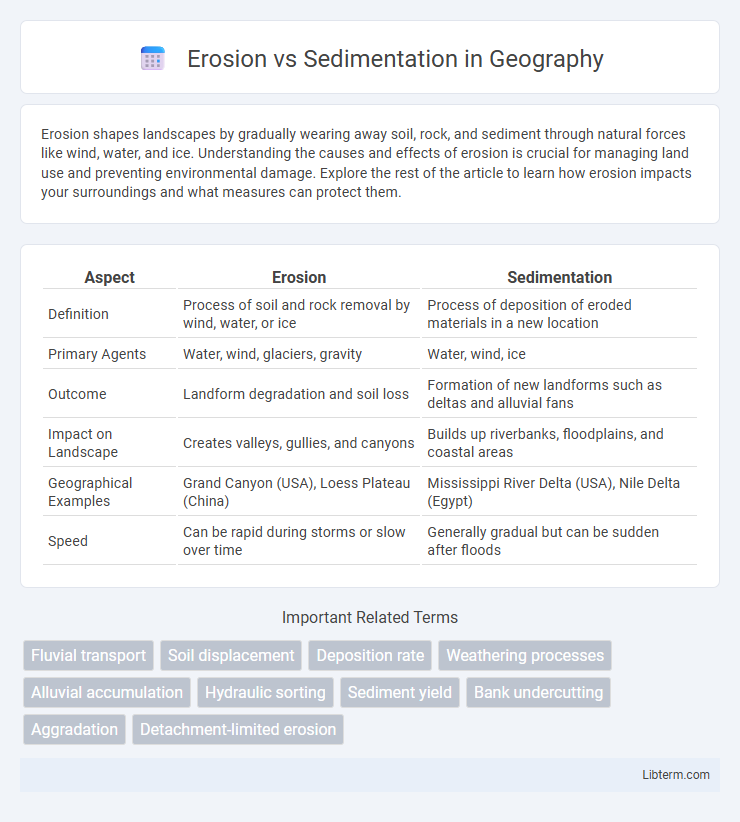Erosion shapes landscapes by gradually wearing away soil, rock, and sediment through natural forces like wind, water, and ice. Understanding the causes and effects of erosion is crucial for managing land use and preventing environmental damage. Explore the rest of the article to learn how erosion impacts your surroundings and what measures can protect them.
Table of Comparison
| Aspect | Erosion | Sedimentation |
|---|---|---|
| Definition | Process of soil and rock removal by wind, water, or ice | Process of deposition of eroded materials in a new location |
| Primary Agents | Water, wind, glaciers, gravity | Water, wind, ice |
| Outcome | Landform degradation and soil loss | Formation of new landforms such as deltas and alluvial fans |
| Impact on Landscape | Creates valleys, gullies, and canyons | Builds up riverbanks, floodplains, and coastal areas |
| Geographical Examples | Grand Canyon (USA), Loess Plateau (China) | Mississippi River Delta (USA), Nile Delta (Egypt) |
| Speed | Can be rapid during storms or slow over time | Generally gradual but can be sudden after floods |
Introduction to Erosion and Sedimentation
Erosion is the process by which soil, rock, or dissolved material is removed from one location and transported to another, primarily by wind, water, or ice. Sedimentation occurs when these eroded materials settle and accumulate in new locations, forming layers that can influence soil fertility and landscape formation. Both processes are integral to shaping Earth's surface and are critical in environmental management and geology.
Defining Erosion: Causes and Processes
Erosion is the natural process by which soil, rock, and sediment are worn away and transported by wind, water, ice, or gravity. Key causes include rainfall impact, river flow, glacial movement, and wind abrasion, which detach and carry surface materials. The processes involved include hydraulic action, abrasion, and chemical weathering, each contributing to landscape changes and sediment redistribution.
Understanding Sedimentation: Mechanisms and Types
Sedimentation occurs when eroded particles settle out of water, wind, or ice, forming layers of sediment in various environments such as rivers, lakes, and oceans. Key mechanisms include gravitational settling, where heavier particles drop rapidly, and flocculation, in which fine particles clump together and settle more easily. Different types of sedimentation--such as clastic, chemical, and biological--reflect the origin and composition of the deposited material, shaping diverse geological features over time.
Natural Factors Influencing Erosion
Natural factors influencing erosion include rainfall intensity, soil composition, vegetation cover, and topography. Heavy rainfall causes surface runoff that accelerates soil displacement, while loose or sandy soils are more prone to erosion than clay-rich soils. Steep slopes and sparse vegetation increase the likelihood of erosion by reducing soil stability and water infiltration.
Human Activities Impacting Sedimentation
Human activities such as deforestation, urban development, and agriculture significantly increase sedimentation rates by destabilizing soil and enhancing surface runoff. Construction projects and mining operations expose loose soil, contributing to excess sediment entering waterways and altering aquatic ecosystems. Effective land management practices are essential to mitigate sedimentation caused by human-induced disturbances and protect water quality.
Key Differences Between Erosion and Sedimentation
Erosion involves the process of wearing away soil, rock, or other surface materials through natural forces such as water, wind, or ice, whereas sedimentation refers to the accumulation and deposition of these eroded materials in new locations. Erosion primarily causes the displacement and transport of particles, while sedimentation results in the formation of sediment layers that can create landforms like deltas and sandbars. The key difference lies in erosion being a destructive process breaking down Earth's surface, contrasted with sedimentation as a constructive process building up geological features.
Environmental Consequences of Erosion
Erosion accelerates soil degradation by removing nutrient-rich topsoil, leading to reduced agricultural productivity and habitat loss. Sedimentation from eroded materials causes water bodies to become shallower, disrupting aquatic ecosystems and increasing flood risks. The environmental consequences of erosion include diminished water quality, loss of biodiversity, and heightened vulnerability of landscapes to further environmental stress.
Effects of Sedimentation on Ecosystems
Sedimentation significantly impacts ecosystems by altering water quality and disrupting aquatic habitats. Excess sediment can smother coral reefs, reduce light penetration in water bodies, and clog fish gills, leading to decreased biodiversity. Sediment accumulation also changes riverbeds and wetlands, affecting nutrient cycling and the survival of sensitive plant and animal species.
Prevention and Management Strategies
Effective erosion prevention and sedimentation management strategies include implementing vegetative cover, such as grasses and shrubs, to stabilize soil and reduce surface runoff. Engineering solutions like silt fences, sediment basins, and terracing are essential in controlling soil displacement and capturing sediment before it enters waterways. Integrated watershed management practices promote sustainable land use, combining physical barriers with policy enforcement to minimize environmental impact and maintain soil health.
Future Trends in Erosion and Sedimentation Research
Advancements in remote sensing technology and machine learning algorithms are revolutionizing erosion and sedimentation research, enabling precise real-time monitoring and predictive modeling of soil degradation patterns. Climate change-induced alterations in precipitation and vegetation cover are driving new studies on their impact on sediment transport and watershed dynamics, highlighting the need for adaptive land management strategies. Emerging interdisciplinary approaches integrating geomorphology, hydrology, and environmental engineering are fostering innovative solutions to mitigate erosion and sedimentation effects on ecosystems and infrastructure.
Erosion Infographic

 libterm.com
libterm.com